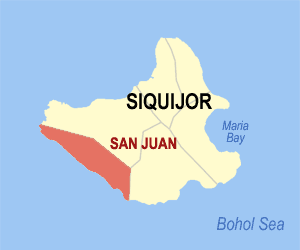Up to the middle part of the 19th century, the town of San Juan, formerly a tribal village known as Capilay, was a part of the vast municipality of Siquijor while its eastern fringes were a part of the vast municipality of Lazi.
San Juan was organized as a new and distinct municipality in the sub-province of Siquijor, Negros Oriental by virtue of the “Acta del Ano 1863”. This document which concluded the negotiation for the creation of the new municipality of San Juan was negotiated by the governadorcillos of the municipalities of Lazi and Siquijor. Don Francisco Ortiz was sent by the politico military governor of Cebu, Don Miguel Creus y Campus to represent him and to act as moderator in the negotiation. It was also attended by the curas parrocos of the two older municipalities and by prominent residents of the then town site of San Juan.
Worded in Castillan, the historic document defined the intentions of the inhabitants of San Juan and delineated the present territorial boundaries of the new municipality. It considerably reduced the size of the municipality of Siquijor while it also resulted in a slight shrinkage on the part of Lazi. Although the Acta was signed by the parties concerned on October 24, 1863, it was only in the November 6, 1863 when the district government ratified the document.
San Juan is the tourism center of the province. It has both historical and natural tourist attractions, which include a centuries-old catholic church, beaches, islet, spring and caves.
In the heart of the poblacion is the scenic municipal park enhanced by a natural spring, which waters the municipal swimming pool. Overlooking the park is the historical century-old San Agustin Parish Church.
This page is last updated on

 Mark Anthony Maranga is an Educator-Parent to his 3 Homeschooling Kids. He sells
Mark Anthony Maranga is an Educator-Parent to his 3 Homeschooling Kids. He sells 










